World Environment Day encourages action for protection of the environment. This event is widely celebrated all over the world, in more than 100 counties. This is a day to draw attention of the policy makers to conserve the environment and for all others to get involved in activities related to protection of the environment, individually, locally, nationally or globally.
The Theme for this year is “Beat Air Pollution”, where air pollution has become a severe environmental concern all over the world. This year the global host country is China, a country with high air pollution, where it is expected to high light the issues in relation to the theme and support taking action to solve them. Delhi city of our neighbouring country too is a well known city with high air pollution.
It has also been found that nine out of ten people in the world are living under polluted atmospheric conditions, or breathing polluted air, where seven million people worldwide die prematurely each year due to air pollution and four million are from Asia Pacific region.
Air pollution was generally linked with respiratory and heart diseases, but now it has been found that it can cause, diabetes, dementia impaired cognative development and lower intelligence levels.
Sri Lanka emphasize on “Minimization of Air Pollution through Sustainable Forest Management” where trees absorb carbon dioxide, other pollutants and release oxygen, purifying air. Therefore by increasing the forest cover, or growing trees we can minimize air pollution. At present Sri Lanka has a forest cover of 29.7% and it is expected to increase it up to 32% by 2030. Phytoplanktons (small micro plants) in the sea too absorbs carbon dioxide and releases oxygen.
The main event in Sri Lanka will be held at the BMICH, on June 6, under the patronage of the President and the Minister of Environment Maithripala Sirisena. An “Environment Week’ was declared from May 30 to June 5.
May 30 Day of Cleaning Environment and raising Awareness on Environment.
May 31 Day of minimizing Air Pollution and its Harmful effects
June 01 Tree Planting Day
June 02 Water and Water Sources Conservation Day
June 03 Biodiversity Conservation Day
June 04 Sustainable Land Management Day
June 05 World Environment Day
 All the agencies under the Ministry of Mahaweli Development and Enviornment has implemented many programmes thoughout the country through their central and regional offices to commemorate this event during the “ Enviornment Week”.
All the agencies under the Ministry of Mahaweli Development and Enviornment has implemented many programmes thoughout the country through their central and regional offices to commemorate this event during the “ Enviornment Week”.
The agencies are Central Enviornmental Authority, Mahaweli Authority, Forest Department, Geological and Mines Bureau, Gem & Jewellery Authority, Gem and Jewellery Research and Training Institute, State Timber Corporation, Coast Conservation Department, Marine Enviornment Protection Agency, Central Engineering Consultancy Bureau. In addition the general public, private sector, Non Governmental Agencies, Community Based Organizations too has joined hands in implementing programmes.
Air pollution occurs when the air gets contaminated with physical, chemical or biological agents and becomes harmful to animals, plants and human beings. Some of the main pollutants are Particulate Matter (PM) or generally known as very small dust or other particles, Carbon Dioxide, Carbon Monoxide, Ozone gas, Nitrogen Dioxide and Sulphur Dioxide. Methane gas is emitted from waste dumps due to fermentation of bio degradable waste.
Air pollutants like carbon dioxide, methane, nitrous oxide, ozone are major green house gases, which causes global warming and climate change.
Biological agents like bacteria, fungi too can contaminate the air causing many diseases.
The main cause of air pollution in the country is vehicular emissions. Industrial emissions, burning of waste, accumulation of waste, (waste dumps), construction activities, spraying of chemicals, forest fires are some of the other causes of air pollution.
Indoor air pollution is somewhat a neglected area, which needs attention. The pollutants are two to five times more concentrated in indoors and as many people are living indoors for longer periods during the day, it is important that we pay our attention to improve the air quality indoors.
Cooking with firewood without proper ventilation, fumigating indoor unnecessarily, spraying low quality chemical fragrances, paints, chemicals, inadequate cleaning of dust can cause indoor air pollution. Unhealthy indoors can cause sick building syndrome, with symptoms like headaches and vomiting fatigue.
Air quality is degraded in the Colombo city due to vehicular emissions, industries and dust due to constructions. Kandy and Kurunegala are two cities surrounded by mountains and rocks respectively causing accumulation of air pollutants. Most of the major cities face air pollution issues due to traffic congestions.
Air pollution can mainly be minimized by proper maintenance of vehicles, to minimize emissions, by controlling and purifying industrial emissions, minimizing burning of waste specially plastics and polythene, which emits carcinogenic gasses, namely dioxin and furan.
Indoor air pollution can be minimized by improving ventilation in kitchens and using improved cooking stoves. Minimizing unnecessary fumigations and spraying of chemicals.
Vertical Forest gardens are introduced to improve air quality in cities, where plants/trees are grown on high rising buildings.
Verticle
Sri Lankan experience of greening the buildings with growing plants.
NASA has recommended ten indoor plants which are capable of absorbing not only Carbon Dioxide but also carcinogens like, benzene, xylene and formaldehyde. Let us take action to minimize air pollution to protect the environment and human health.
The writer is an Assistant Director, Environment Pollution Control and Chemical Management Division, Ministry of Mahaweli Development and Environment.




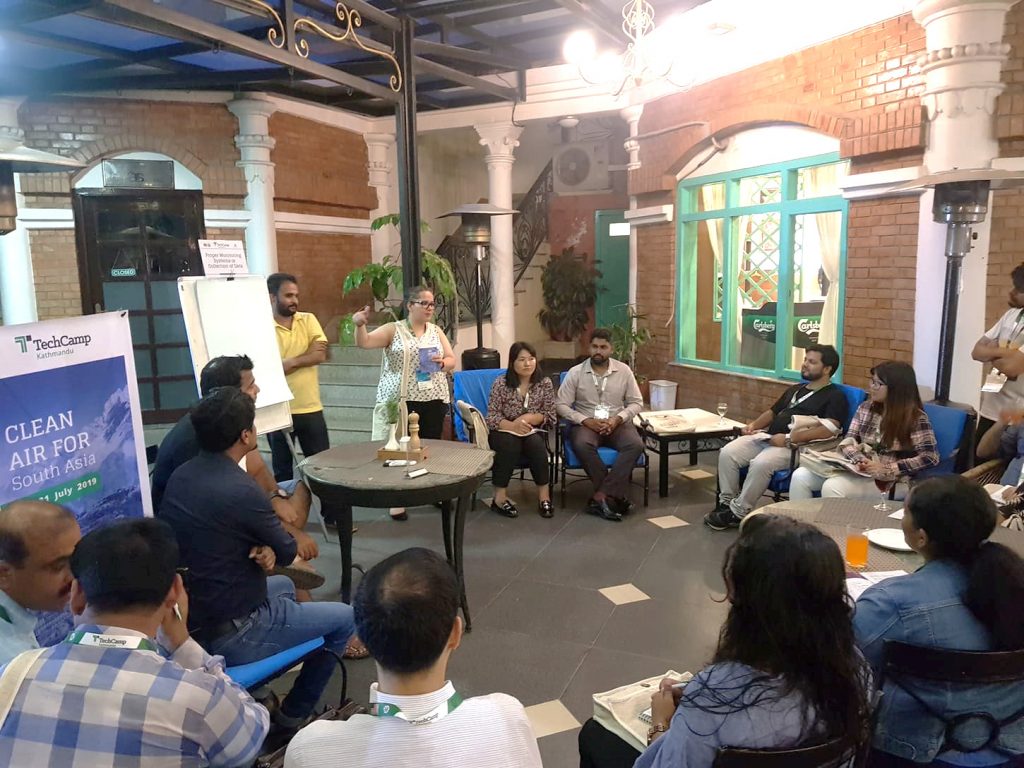
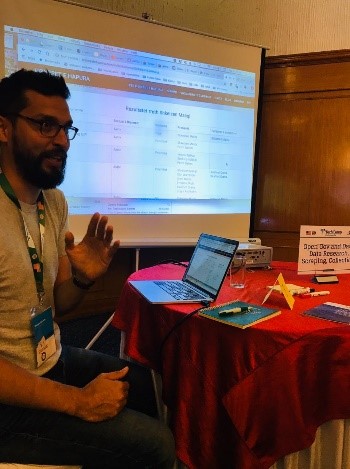
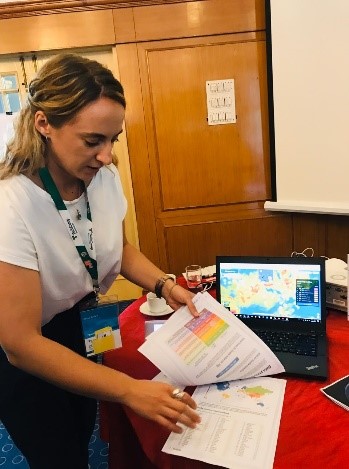


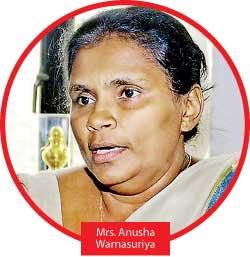 According to the heat advisory issued by the Med Department, the 14 districts that are likely to be affected are Jaffna, Kilinochchi, Mannar, Mullaitivu, Vavuniya, Trincomalee, Anuradhapura, Puttalam, Polonnaruwa, Kurunegala, Monaragala, Batticaloa, Ampara and Hambantota.
According to the heat advisory issued by the Med Department, the 14 districts that are likely to be affected are Jaffna, Kilinochchi, Mannar, Mullaitivu, Vavuniya, Trincomalee, Anuradhapura, Puttalam, Polonnaruwa, Kurunegala, Monaragala, Batticaloa, Ampara and Hambantota.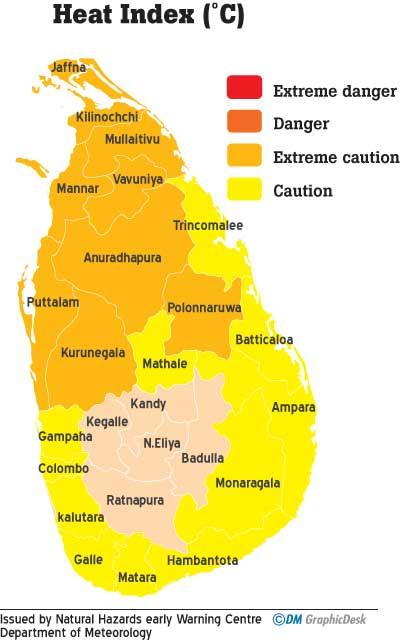 The Meteorology Department said that the Heat Index Forecast is calculated by using relative humidity and maximum temperature and this is the condition that is felt on the body.
The Meteorology Department said that the Heat Index Forecast is calculated by using relative humidity and maximum temperature and this is the condition that is felt on the body.
 All the agencies under the Ministry of Mahaweli Development and Enviornment has implemented many programmes thoughout the country through their central and regional offices to commemorate this event during the “ Enviornment Week”.
All the agencies under the Ministry of Mahaweli Development and Enviornment has implemented many programmes thoughout the country through their central and regional offices to commemorate this event during the “ Enviornment Week”.
